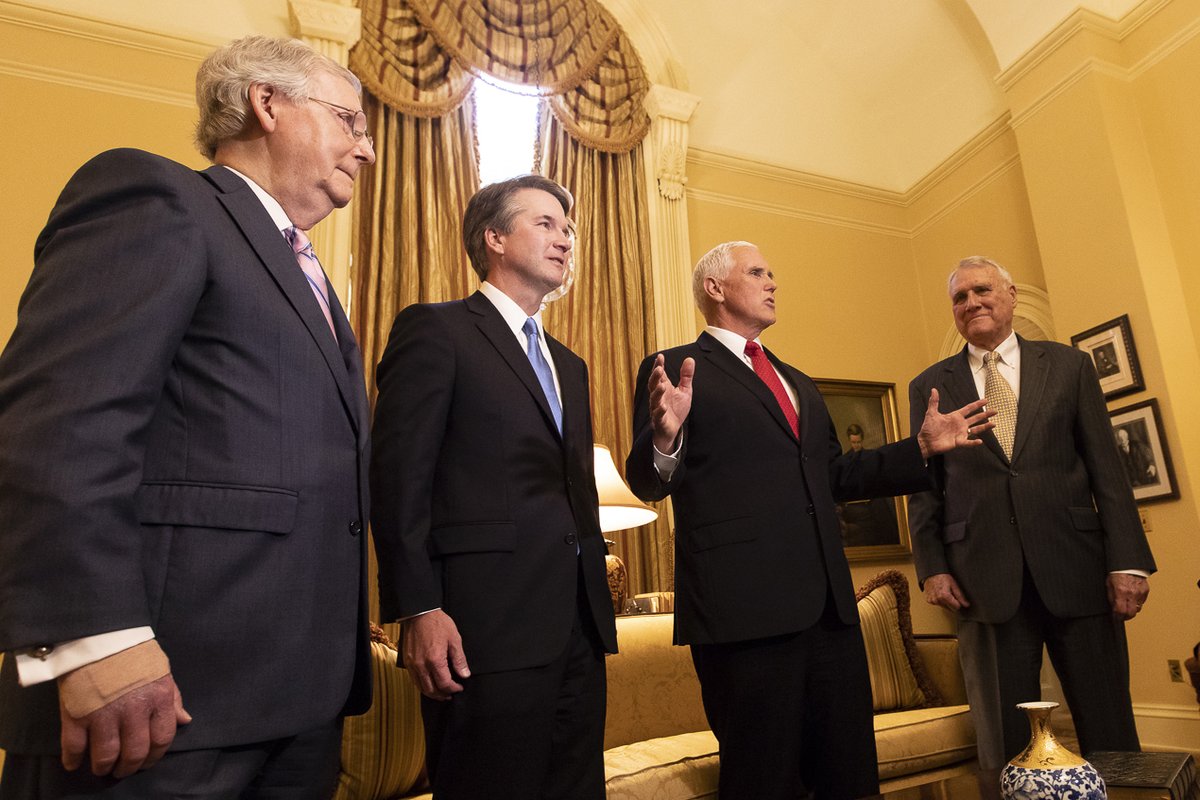Current status: The Senate has voted narrowly to confirm Brett Kavanaugh as the newest member of the Supreme Court.
Originally written 11:00 PM 9/27/18.
1:30 PM 10/6/18: Updated with results of confirmation vote.
3:00 PM 10/5/18: Updated with Collins’ and Manchin’s announcements of support for Kavanaugh.
8:30 AM 10/5/18: Updated with results of the cloture vote.
10:00 PM 10/4/18: Updated with details on the Senate’s voting schedule and on undecided Senators declaring their decisions on whether or not to vote for Kavanaugh.
9:30 PM 10/3/18: Updated due to the delivery of the FBI’s report and the scheduling of a Senate vote.
12:30 PM 9/28/18: Updated with Flake’s compromise, which moves the nomination from the Judiciary Committee to the full Senate, but delays the vote to confirm Kavanaugh by one week, while asking the White House to open an FBI investigation.
8:30 AM 9/28/18: This article has been updated to reflect Flake’s choice to vote to recommend Kavanaugh favorably and the subsequent walkout by some Democratic senators from Judiciary Committee proceedings.
*****
The process of selecting a new member of the Supreme Court is a long and complicated one. With Judge Brett Kavanaugh’s confirmation hearings attracting attention and activism, The Paper Tiger decided to break down the procedure for you.
The United States Constitution says that the president “shall nominate, and by and with the Advice and Consent of the Senate, shall appoint… Judges of the supreme Court.” In the centuries since that clause was written, a more nuanced procedure has evolved to handle Supreme Court nominations.
- The President nominates someone to replace a retiring or dead Supreme Court Justice (Trump completed this on Tuesday, July 10)
The president’s advisors typically make a shortlist of potential nominees, from whom the president selects one to nominate. In this case (and that of Justice Neil Gorsuch last year), White House Counsel Doug McGahn probably crafted the shortlist before President Donald Trump chose Kavanaugh, a judge on the District of Columbia Court of Appeals — the second most powerful court in America — and announced his decision in a press conference.
- The Senate Judiciary Committee holds hearings on the nomination (completed on Thursday, September 27)
Next, the Judiciary Committee — one of 16 standing committees of the Senate — hears testimony from the nominee and other interested parties. The Chairman of the committee (currently Republican senator Chuck Grassley), a member of the majority party in the Senate, runs the hearings. These can last for weeks, with senators taking a close look at the nominee’s judicial record and prior writings, and are the most public moments in the process. In the last forty years, when nominations have failed, it has been because of information uncovered in the Judiciary Committee — after controversial hearings, President George W. Bush withdrew his nomination of Harriet Miers, and the Senate voted not to confirm Robert Bork, who was nominated by Ronald Reagan.
After hearings from September 4-7, the Judiciary Committee seemed to be done hearing testimony. However, about a week later, reports first surfaced that Senator Dianne Feinstein, the most senior Democrat on the committee, had in her possession a letter containing allegations of sexual assault against Kavanaugh. Senator Grassley agreed to hold additional hearings to hear testimony from Dr. Christine Blasey Ford, the author of the letter, and Kavanaugh, which took place on September 27.
- The Senate Judiciary Committee votes on whether to “recommend” the nominee (completed on Friday, September 28)
After hearing testimony, the Judiciary Committee gives its advice to the whole Senate in the form of a recommendation on whether to confirm the nominee. Most recent nominations have received “favorable” recommendations. The Senate voted against confirming Bork, the only nominee to receive an “unfavorable” rating, but for Justice Clarence Thomas, for whom the committee elected not to deliver a rating at all. Notably, Thomas was accused of sexual harassment in a set of hearings widely compared to Kavanaugh’s.
The vote took place just after 10:30 AM Pacific Time on Friday, September 28. With 11 Republicans and 10 Democrats on the committee, the vote was guaranteed to be tight. All eyes were on Jeff Flake of Arizona, the only Republican on the committee who broke ranks with his party to call for hearings to allow Ford to present her story. Though he noted that “there’s more doubt than certainty” at the hearing, he declined to ask questions of either Ford or Kavanaugh directly.
Four Democratic senators, including California senator Kamala Harris, walked out of the vote. According to Mazie Hirono of Hawaii, one of the four, the walkout was not planned, but left in the passion of the moment. (If it had been pre-planned, at least nine of the Democrats would likely have left, preventing the committee from having enough senators from each party to call a vote.) Grassley strongly rebuked Democrats for “breaking [the] rules and customs” that make the Senate function. They later returned to the chamber.
Immediately before the vote, Flake announced a new plan for how to handle the nomination going forward. The Judiciary Committee would vote to recommend Kavanaugh to the Senate as a whole, concluding their role in the process. However, Republican leadership would also delay the vote to confirm Kavanaugh for a week to create time for a potential further FBI investigation into the claims against the nominee.
On the night of Wednesday, October 3, the FBI delivered its report to the Senate. Senators on the Judiciary Committee were able to read the secret report on Thursday morning, and then the file was made available to all Senators through the rest of the day (though their staffers will not be allowed to view it).
- The full Senate debates the nomination (completed on Friday, October 5)
Historically, if a nominee gets a positive recommendation from the Judiciary Committee, their eventual victory in a full-Senate vote is all but assured. However, senators of all parties get a chance to share their opinions in open debate first, a potential opportunity for a filibuster.
Until recently, Republicans, who hold 51 of the Senate’s 100 seats, would have needed substantial Democratic support to block a filibuster through a motion called “cloture,” which prevents a senator from speaking indefinitely. However, a Senate rule change on April 6, 2017, conveniently allows a 51-seat majority to invoke cloture on the filibuster of a Supreme Court nominee. Thus, for a filibuster to succeed, undecided Republicans would have to side with Democrats against a cloture motion.
On Friday, October 5, the Senate voted in favor of cloture by a vote of 51-49.
- The full Senate votes on whether to confirm the nominee as a Supreme Court Justice (Completed on Saturday, October 5)
The final step in the confirmation process is also the most straightforward. A final vote occurs as soon as 30 hours after the motion for cloture passes. If the majority of senators vote in favor of the nominee, they become the next Supreme Court Justice. If not, the president must either nominate a new candidate or re-nominate the old one. In the case of a tie, as with all votes in the Senate, the vice-president may cast a tie-breaking vote.
Since Vice-President Mike Pence supports Brett Kavanaugh, Republican leadership only needs 50 votes. As late as Thursday night, 48 Republicans appeared committed to the nominee, and at least 48 Democrats had announced their opposition, creating a ridiculously tight, evenly balanced situation.
That left all eyes on four swing votes: Flake, Democrat Joe Manchin of West Virginia, and Republicans Susan Collins of Maine and Lisa Murkowski of Alaska. The four met with each other frequently, suggesting that they might all decide to vote the same way. However, in the cloture vote on Friday, Flake, Collins, and Manchin voted to advance Kavanaugh’s confirmation to a final vote, while Murkowski voted against doing so. In a fiery speech on the Senate floor on Friday, Collins announced that she will vote to confirm Kavanaugh. Ultimately, though Murkowski did not join them, Collins, Flake, and Manchin provided the winning margin to send Kavanaugh to the Supreme Court.







